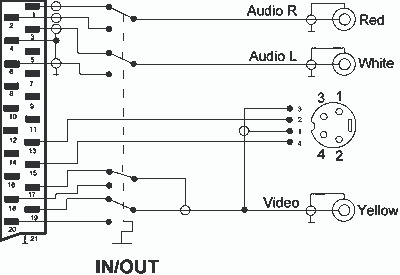Ef þú finnur ekki svona "color fixer" þá getur þú bara mixað snúruna til að gera það sama og color fixerinn gerir..
Tutorial til að colorfixa "composite/s-video > scart" breytistykki:
http://camp0s.altervista.org/sVideo/how_to.htmÉg var með þetta allt í einni snúru ss. "s-video + hljóð > scart" svo ég opnaði bara scart hausinn og lóðaði saman hausana bakvið pinna 20 og 15. Hef gert þetta tvisvar sinnum og virkað mjög vel í bæði skiptin. Á víst að vera einhver gæðatap við að nota þetta fix, en ég tek ekki eftir því hjá mér.
Ert basicly að breyta merkinu yfir í composite frá s-video með þessu fixi, þar sem það eru mörg tæki sem eru ekki mótækileg fyrir s-video merki í gegnum scart. Helsti munurinn á s-video og composite er að s-video sendir Luminance(birta) og Chrominance(litur) í sitthvorulægi en ef þú sameinar pinnana þá senda þeir merkið út eins og composite..
Hérna er skýring á þessu á ensku:

SCART S-Video Connection
Output S-Video Connector
1; Audio right out
3; Audio left (or mono) out
4; Audio return
15; Chrominance out
13; Chrominance return
8; Video status out
19; Luminance out
17; Luminance return
21; Shield
Input S-Video Connector
2; Audio right in
6; Audio left (or mono) in
4; Audio return
15; Chrominance in
13; Chrominance return
8; Video status in
20; Luminance in
18; Luminance return
21; Shield
SCART Composite Video Connection
Output Composite Connector
1; Audio right out
3; Audio left (or mono) out
4; Audio return
8; Video status out
19; Composite video out
17; Composite video return
21; Shield
Input Composite Connector
2; Audio right in
6; Audio left (or mono) in
4; Audio return
15; Chrominance in
13; Chrominance return
8; Video status in
20; Composite video in
18; Composite video return
21; Shield
In composite video, the luminance signal is low-pass filtered to prevent
crosstalk between high-frequency luminance information and the color
subcarrier. In S-Video Color and Luminance signals are separated in cable, so
low-pass filtering isn"t needed. This increases bandwidth for the luminance
information, subdues the color crosstalk problem and leaves more video
information intact, thus having a improved image reproduction compared to
composite video.
Due to the separation of the video into brightness and colour components,
S-Video is sometimes considered a type of component video signal, although
it is also the most inferior of them, quality-wise, being far surpassed by the
more complex component video schemes (like RGB). What differentiates
S-Video from these higher component video schemes is that S-Video carries
the colour information as one signal. This means that the colours have to be
encoded in some way, and as such NTSC, PAL and SECAM signals are all
decidedly different through S-Video. Thus, for full compatibility the used
devices not only have to be S-Video compatible but also compatible in terms
of colour encoding.
Pin 1; GND, Ground (Y)
Pin 2; GND, Ground (C)
Pin 3; Y, Intesity (Luminance)
Pin 4; C, Color (Chrominace)
The luminance (Y; greyscale) signal and modulated chrominance (C; colour)
information are carried on separate synchronized signal/ground pairs.
S-Video signals are generally connected using 4-pin mini-DIN connectors
using a 75 ohm termination impedance. Today, S-Video can be transferred
through SCART connections as well. S-Video and RGB are mutually exclusive
through SCART, due to the S-Video implementation using the pins allocated
for RGB. Most SCART-equipped televisions or VCRs (and almost all of the
older ones) do not actually support S-Video, resulting in a black-and-white
picture if attempted to use, as only the luminance signal portion is used.
Black-and-white picture in itself can also be a sign of incompatible colour
encoding, for example NTSC material viewed through a PAL-only device.
A hack exists to possibly attain color on devices that do not support
S-video through SCART. This is done via joining the pins 15 and 20 in
the SCART connector (either directly or using a 470pF capacitor), and
may not yield optimal results.
It is very simple to convert S-Video to composite signal (just the logical
merging of the two through a filter is required) or vice versa.

